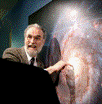Authors
Paul T. O'Brien, University of LeicesterFollow
M. Dietrich, Landessternwarte, KoŽ nigstuhl, D-69117 Heidelberg, Germany
K. Leighly, Columbia Astrophysics Laboratory
D. Alloin, Centre dÏEtudes de Saclay, Service dÏAstrophysique, Orme des Merisiers, 91191 Gif-Sur-Yvette Cedex, France
J. Clavel, ISO Project, European Space Agency, Apartado 50727, 28080 Madrid, Spain
D. Michael Crenshaw, NASA Goddard Space Flight CenterFollow
K. Horne, School of Physics and Astronomy, University of Saint Andrews, North Haugh, Saint Andrews KYI 16 9SS, Scotland, UK
G. A. Criss, Department of Physics and Astronomy, The Johns Hopkins University, Baltimore,MD
Julian Henry Krolik, Johns Hopkins UniversityFollow
Matthew A. Malkan, University of California, Los AngelesFollow
Hagai Netzer, Tel Aviv UniversityFollow
Bradley M. Peterson, Ohio State UniversityFollow
G. A. Reichert, NASA Goddard Space Flight Center, Code 631, Greenbelt,MD
P. M. Rodriguez-Pascual, ESA IUE Observatory, P.O. Box 50727, 28080 Madrid, Spain
W. Wamsteker, ESA IUE Observatory, P.O. Box 50727, 28080 Madrid, Spain
K. S.J. Anderson, New Mexico State UniversityFollow
N. G. Bochkarev, Sternberg Astronomical Institute, M.V. Lomonosov Moscow State University, Universitetskij Prospect, 13, Moscow 119899, Russia
F.-Z. Cheng, Center for Astrophysics, University of Science and Technology, Hefei, Anhui, PeopleÏs Republic, of China
A. V. Filippenko, University of California, BerkeleyFollow
C. Martin Gaskell, University of Nebraska-LincolnFollow
I. M. George, Laboratory for High Energy Astrophysics, NASA Goddard Space Flight Center, Greenbelt,MD
M. R. Goad, Space Telescope Science Institute, 3700 San Martin Drive, Baltimore,MD
L. C. Ho, Harvard-Smithsonian Center for Astrophysics, 60 Garden Street, Cambridge, MA
Shai Kaspi, Tel Aviv UniversityFollow
W. Kollatschny, UniversitaŽts-Sternwarte GoŽ ttingen, Geismarlandstrasse 11, D-37083 GoŽ ttingen, Germany
Kirk T. Korista, Western Michigan UniversityFollow
G. MacAlpine, Department of Astronomy, University of Michigan, Dennison Building, Ann Arbor, MI 48109
D. Marlow, Nuffield Radio Astronomy Laboratory, University of Manchester, Jodrell Bank, MacclesÐeld, Cheshire SK11 9DL, England, UK
P. G. Martin, Canadian Institute for Theoretical Astrophysics, University of TorontoFollow
S. L. Morris, Dominion Astrophysical Observatory, 5071 West Saanich Road, Victoria, British Columbia V8X 4M6, Canada
Richard William Pogge, Ohio State UniversityFollow
B. C. Qian, Shanghai Astronomical Observatory, Chinese Academy of Sciences, 80 Nandan Lu, Shanghai 20030, China
M. C. Recondo-Gonzalez, ESA IUE Observatory, P.O. Box 50727, 28080 Madrid, Spain
J. M. Rodriguez Espinosa, ESA IUE Observatory, P.O. Box 50727, 28080 Madrid, Spain
M. Santos-Lleo, LAEFF, Apartado 50727, E-28080 Madrid, Spain
A. I. Shapovalova, Special Astrophysical Observatory, Russian Academy of Sciences, Nizhni Arkhiz, Karachaj-Cherkness Region, 357147, Russia
J. M. Shull, Joint Institute for Laboratory Astrophysics, University of Colorado, and National Institute for Standards and Technology, Campus Box 440, Boulder, CO
G. M. Stirpe, Osservatorio Astronomico di Bologna, Via Zamboni 33, I-40126, Bologna, Italy
W.-H. Sun, Institute of Astronomy, National Central University, Chung-Li, Taiwan 32054, Republic of China
T. J. Turner, Universities Space Research Association
R. Vio, ESA IUE Observatory, P.O. Box 50727, 28080 Madrid, Spain
S. Wagner, Landessternwarte, KoŽnigstuhl, D-69117 Heidelberg, Germany
I. Wanders, Department of Astronomy, The Ohio State University, 174 West 18th Avenue, Columbus, OH
K. A. Wills, Nuffield Radio Astronomy Laboratory, University of Manchester, Jodrell Bank, MacclesÐeld, Cheshire SK11 9DL, England, UK
H. Wu, Beijing Astronomical Observatory, Chinese Academy of Sciences, Beijing 100080, People's Republic of China
S. J. Xue, Center for Astrophysics, University of Science and Technology, Hefei, Anhui, People's Republic, of China
Z.-L. Zou, Beijing Astronomical Observatory, Chinese Academy of Sciences, Beijing 100080, People's Republic of China
Date of this Version
12-10-1998
Abstract
As part of an extensive multi-wavelength monitoring campaign, the International Ultraviolet Explorer satellite was used to observe the broad-line radio galaxy 3C 390.3 during the period 1994 December 31-1996 March 5. Spectra were obtained every 6È10 days. The UV continuum varied by a factor of 7 through the campaign, while the broad emission lines varied by factors of 2È5. Unlike previously monitored Seyfert 1 galaxies, in which the X-ray continuum generally varies with a larger amplitude than the UV, in 3C 390.3 the UV continuum light curve is similar in both amplitude and shape to the X-ray light curve observed by ROSAT . The UV broad emission-line variability lags that of the UV continuum by 35È70 days for Lyα and C IV, values larger than those found for Seyfert 1 galaxies of comparable UV luminosity. These lags are also larger than those found for the Balmer lines in 3C 390.3 over the same period. The red and blue wings of C IV and Lyα vary in phase, suggesting that radial motion does not dominate the kinematics of the UV line-emitting gas. Comparison with archival data provides evidence for velocity-dependent changes in the Lyα and C IV line profiles, indicating evolution in the detailed properties and/or distribution of the broad-line emitting gas. Joint Institute for Nuclear Research, Dubna, Russia


Comments
Published in THE ASTROPHYSICAL JOURNAL, 509: 163-176 (December 10, 1998). Copyright 1998 The American Astronomical Society. Published by University of Chicago Press. Used by permission.